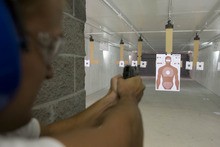This is an archived article that was published on sltrib.com in 2012, and information in the article may be outdated. It is provided only for personal research purposes and may not be reprinted.
Lawmakers are questioning why public shooting ranges ban human-shaped targets.
The Judiciary Interim Committee met Wednesday to address, among other items, a letter from a constituent of Sen. Lyle Hillyard, R-Logan, who complained about the Division of Wildlife Resources Cache Valley Shooting Range not allowing people to shoot at human silhouettes during normal business hours.
The range accommodates special groups, such as law enforcement, outside of those hours but has an informal rule to turn away people who bring such targets with them, said Robin Cahoon, legislative liaison for the DWR. The range instead supplies squirrel and rabbit silhouettes and bull's-eye targets. The human silhouette ban also applies at DWR's second public range in Salt Lake City.
Cahoon said not allowing human-shaped targets was part of the agency's effort to make hunting safer. In 1957, she said, there were 126 hunting-related accidents, 22 of them fatal.
"This sort of accident rate was not tolerable," she said, and prompted a state-mandated hunter education through the DWR in 1960.
The DWR's current philosophy is that human silhouettes are counter-productive to hunter safety, she said. Cahoon said there have been, on average, only six shooting incidents a year and seven fatalities total in the 16 years she's been with the DWR.
"In hunter education, we drive home the lesson that you should never point your firearm at something you do not intend to shoot, like other hunters," Cahoon said.
That makes sense to Steve Gunn, a gun-control advocate with the Gun Violence Prevention Center of Utah. Hunters must be cautious in the use of their firearms, he said. If the DWR's philosophy is intended to remind hunters of that, Gunn said he applauds the target ban.
"It seems to me that if a person wants to target practice, that a bull's-eye is every bit as effective" as a silhouette, he said.
But Hillyard said people should have the choice to shoot at human silhouettes to train in lawful self-defense, and that other targets may not be sufficient. As an example, he said, shooting clay pigeons is very different from shooting live geese.
The human silhouette is an industry standard for self-defense training, said Clark Aposhian, chairman of the Utah Shooting Sports Council. Besides, shooting ranges are disappearing, and people who should be able to practice are "being turned away because of their choice of target, because of subjectivity and hypersensitivity," Aposhian said.
Sen. Mark Madsen, R-Eagle Mountain, and Senate chairman of the committee, said it seems like a dangerous precedent to allow the DWR ranges, which are funded by taxpayers, to tell citizens what they can and cannot shoot with an unwritten rule. Madsen wants the administrative rules committee to address the issue.
Cahoon said after the meeting that more discussion about the issue should take place before it's taken to the rules committee.



